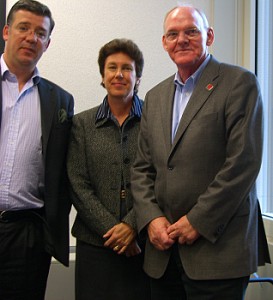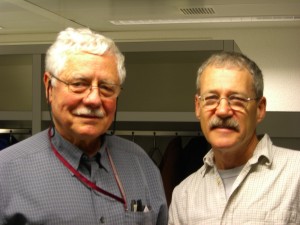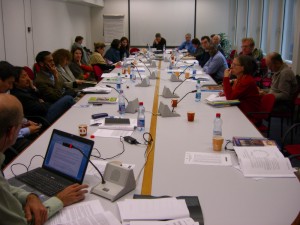FIG President Stig Enemark attends FAO/UN-HABITAT Expert
Group Meeting on Guidelines for Addressing Land Issues after Natural
Disasters
Geneva, Switzerland, 21-23 April 2008
|

Richard Trenchard , FAO, Clarissa Augustinus,
UN-HABITAT, and Stig Enemark, FIG |
FIG President Stig Enemark was invited to attend the
FAO/UN-HABITAT Expert Group Meeting (EGM) held at the UN-HABITAT Office in
Geneva, 21-23 April 2008.
The meeting was invited by Paul Munro-Faure, Chief, Land Tenure
and Management Unit, FAO; and Clarissa Augustinus, Chief, Land,
Tenure and Property Administration, UN-HABITAT. The EGM was organised
jointly by FAO and UN-HABITAT to contribute to the process of developing
Guidelines and a Toolkit for addressing Land Issues after Natural Disasters.
The meeting included about 40 invited experts from the UN Agencies,
humanitarian organisations, and the land profession. The experts discussed
the issues based on a draft for such guidelines provided for FAO-UN-HABITAT
by Daniel Fitzpatrick from the Australian National University. The
objectives of the meeting were to:
- Ensure the guidelines meet the needs of the humanitarian community,
in terms of structure and key issues identified;
- Critically review proposed policy options and recommendations on
sequencing of interventions; and
- Review draft toolkit structure and proposed contents.
As a background, it is understood that land is a fundamental resource for
recovery after disasters. Land provides a site for shelter, a resource for
livelihoods and a place for access services and infrastructure. Secure
rights to land are essential to prevent land grabbing, and allow
reintegration of displaced persons. Land is therefore a cross-cutting issue
in the relief, recovery and development phases of post-crisis programming.
In 2005, the Humanitarian Response Review identified land and property
issues as one of the major gaps in the humanitarian response system. In
2007, the Early Recovery Cluster, led by UNDP, decided to prepare clear and
simple guidelines to support national and international efforts to address
land, tenure and property issues after natural disasters. In response,
UN-HABITAT and FAO are collaborating to prepare a set of guidelines and a
toolkit for addressing land issues following natural disasters.
The meeting was very productive in discussing the key issues as presented
in the draft guidelines. A key focus in the discussion groups was to
facilitate a mutual understanding between the humanitarians and the land
professionals in the process of early recovery. This process describes the
traditional phase the bridges emergency relief and future sustainable
development. Early recovery begins in the emergency relief phase, builds on
humanitarian programming, and takes advantage of opportunities for
sustainable development.
A range of case studies vas provided by consultants including
David
Stanfield, Grenville Barnes, Robert Home, who also
contributed to the discussions from a land professional point of view.
All relevant conference material is available at:
http://www.gltn.net/index.php?option=com_content&task=view&id=114&Itemid=114
FIG is currently considering how to contribute to best addressing the
land issue after natural disasters. This may include a number of activities
ranging from policy development in cooperation with the UN agencies to
professional support in actual disaster situations in cooperation with other
professional organisations.
Read more:
|

David Stanfield, Terra Institute, Madison, Wisconsin, and
Grenville Barnes, University of Florida |

Geneva is beautifully surrounded by mountains.
|
|

Expert Group Meeting with about 40 participants discussing the key
issues. |
|
|


























